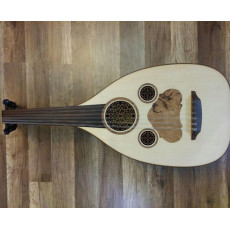
Ghorbanzadeh Bros artistry is unique,their instruments are unique, and the tone their instruments produce is unique. Many of their clients know this, and that's why their list of famous clients is probably sort of endless. A pair of names on that list: Arman Cigarchi & Negar bouban. Their instruments are fully made by hand. They are amazing gifted instruments, built with passion and great knowledge of wood and Lutherie.
Meet this brand new Barbat with triple soundhole.
The Barbat feels smaller because of the way it's build than it actually is, fits perfectly in any lap and has an especially open character.
When you play this Barbat you'll know what I mean, the Barbat is absolutely unique, one of the best balanced instruments I've ever heard, refined and versatile. Because of the open structure of shellac, it's got a very open character whereby the freshness of the bass, even on the higher frets, are remarkable.
This barbat is custom made with 5A grade Engelmann top and very old log of premium indian rosewood back. Even the braces are of the same grade Engelmann.
This Barbat has TRUSSROD.
Sound sample professionally played also by Arman Sigarchi: https://www.youtube.com/watch?v=bt5tpAsgjI8&feature=youtu.be
Engelmann Top:
Engelmann is also known as white spruce. It is usually visually distinguishable from Sitka by its creamier complexion. We're almost out of the “good stuff.” Engelmann trees these days are so small and twisted that we get a fair amount of runout (grain that doesn't run parallel to the surface) and as a result, mismatched tops.
Sonically, Engelmann has a mature tone, and yields a slightly richer midrange than Sitka, which makes an oud sound a bit older. Old growth Engelmann tends to have a sonic attribute of smoothness or refinement to it, but the days of older growth Engelmann trees are essentially gone for now. Good news is that these tops can get matured and old on an instrument, when so, it is difficult to beat that instrument.
The Cedars and Redwoods do not develop dramatically over time like the Spruces. This is primarily because the Spruces contain resins that continue to dry and harden over many years. Cedar and Redwood don’t have resins and sound pretty well developed right off the bench. All Ouds will break in and develop regardless of resin content by virtue of playing and vibration through some magical realignment and relaxing of the wood fibers and molecules. All very scientific!
Action adjustment system
An important problem on almost all Ouds is that the neck rises up after a couple of years due to string's tension which increases the depth of the gap between strings and the finger board. This causes some critical problems:
1- The oudist will have to put more pressure on the strings while fingering. This will cause more pain on the finger tips and make the oudist tired more quickly.
2- The extra pressure causes false notes.
3- This will make it harder for the oudist to perform the techniques correctly.
Moreover, different oudists prefer different actions according to their playing styles. So the luthiers have to make low action or high action Ouds according to their order. Adjusting the action in other instruments is done by changing the top skin (instruments like the Tar and the Kamancheh) or changing the saddle (instruments like Setar or Santour).
Action adjustment system is designed so that the oudist can easily adjust the neck for his desired action. This is done by a number 6 allen screw which is installed on the bowl near the neck and it's not needed to adjust the neck from inside the bowl.
Specs:
Bowl: Indian Rosewood
Neck: Indian Rosewood
Pegbox: Indian Rosewood
Binding: Indian Rosewood
Shams: Rosewood
Rosette: Rosewood
Pegs: Rosewood
Pickguard: Walnut Burl
Brace wood: Engelmann
Fingerboard: Ebony
Soundboard: Engelmann 5A Grade
Glue: Hot Hide glue
Scale: 58.5
Bridge: Rosewood
Nut: Ebony
Finish: Shellac
Top finish: None
Hardcase: Included
Freeshipping insured!
More info, please contact me at: